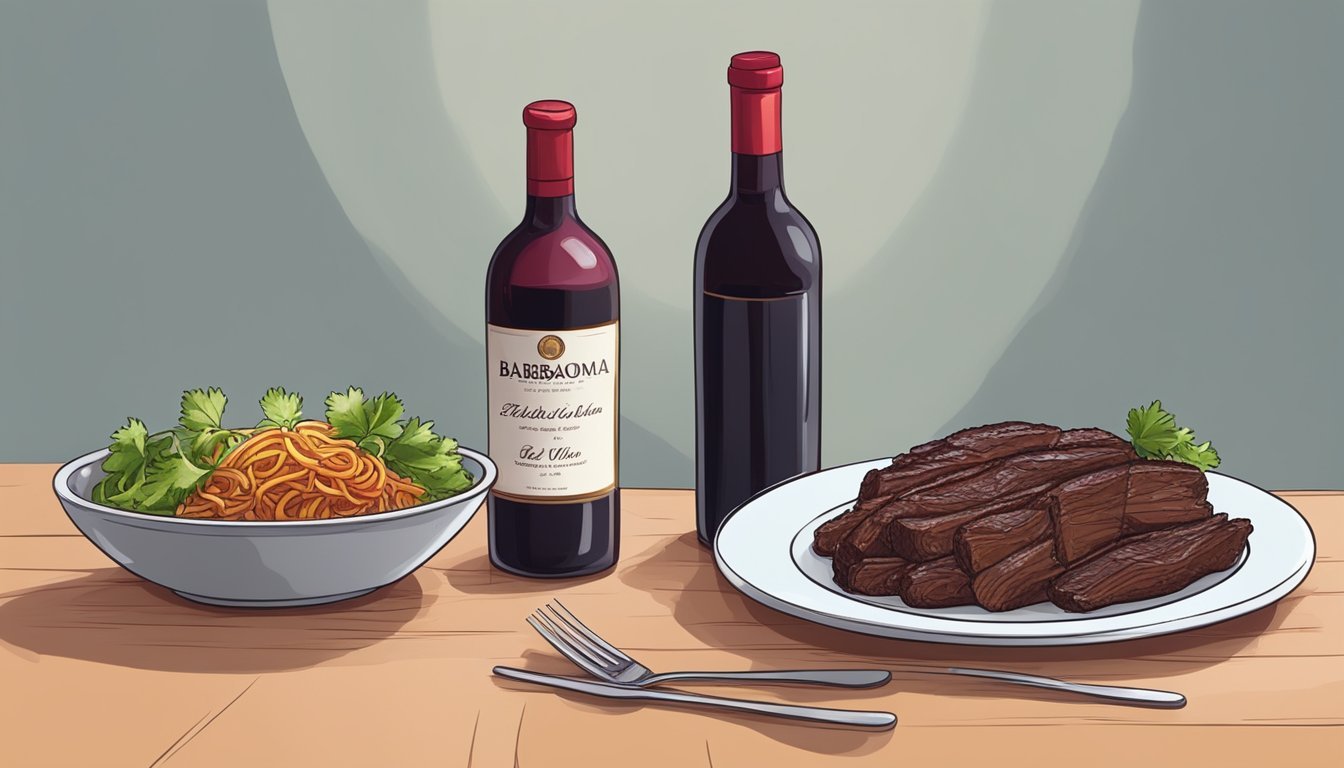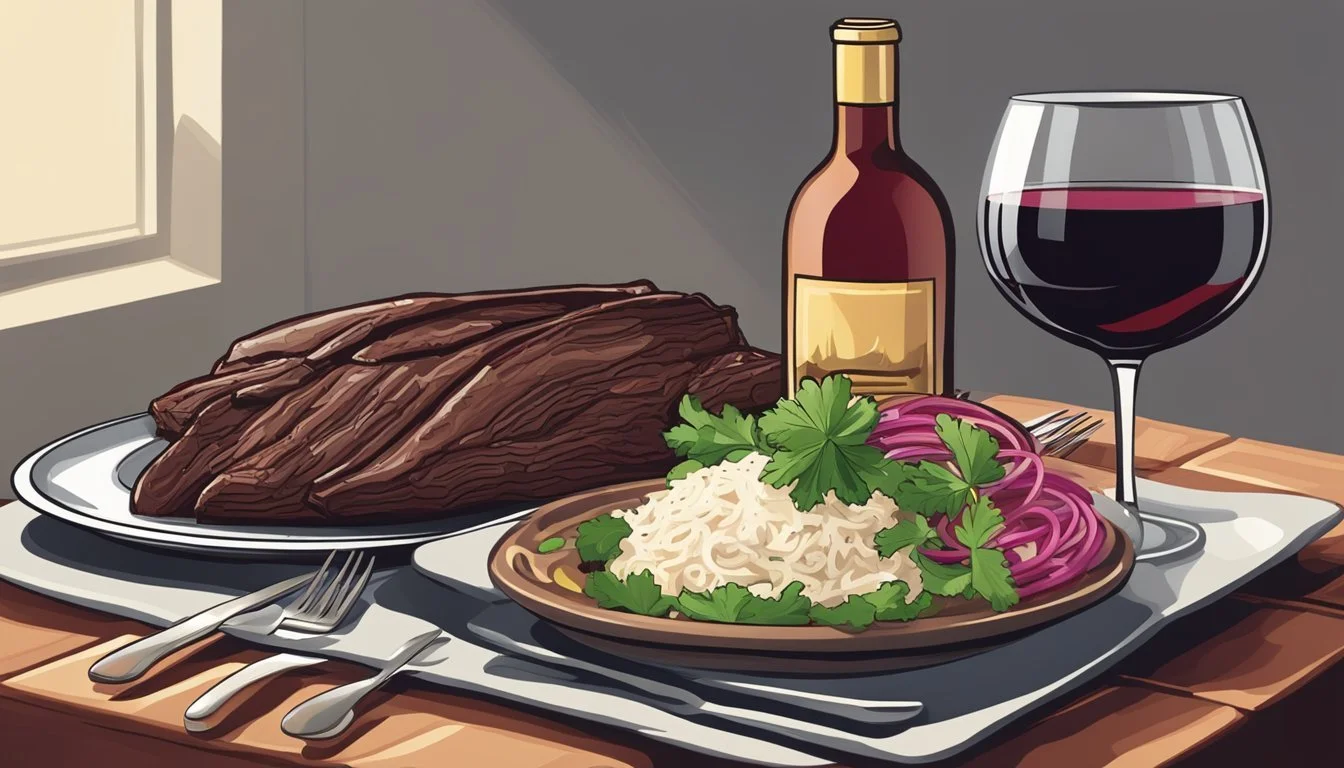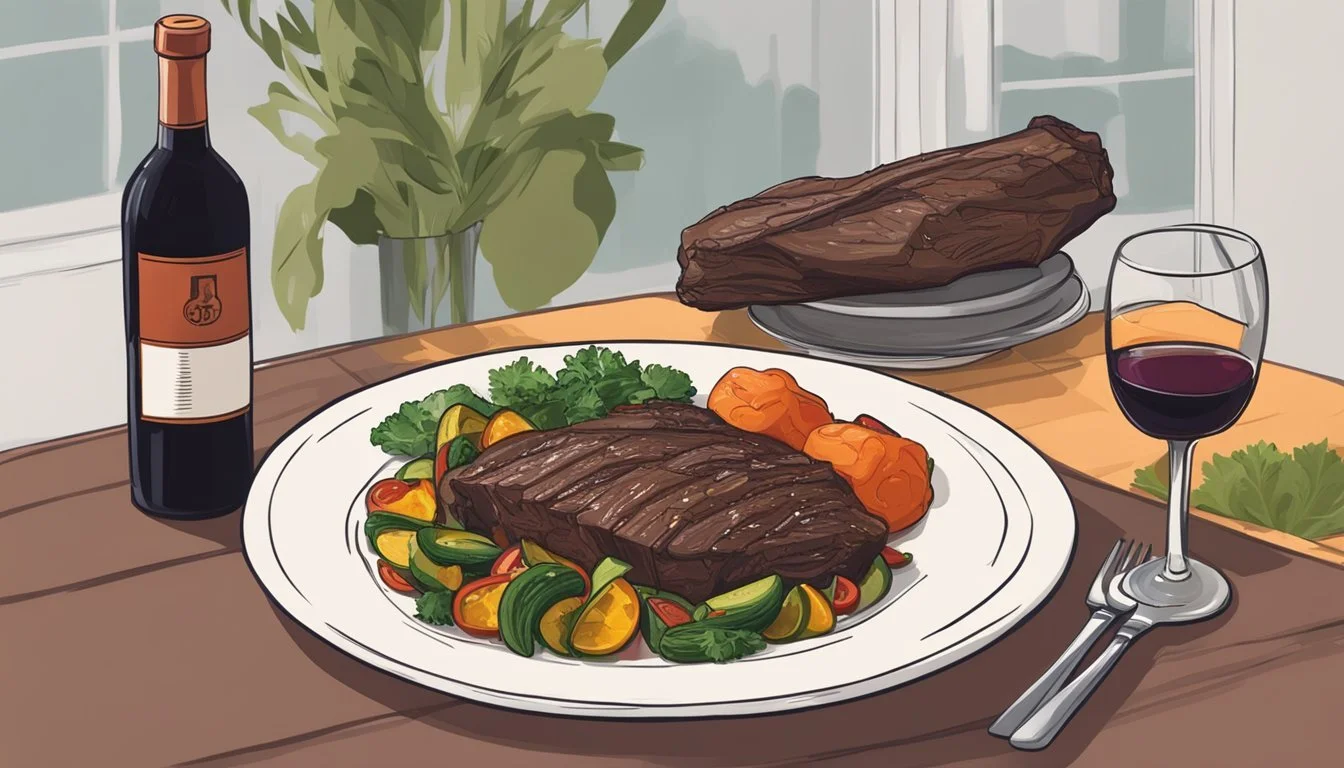What Wine Goes Well with Beef Barbacoa?
The Perfect Pairing Guide
Beef barbacoa, with its rich and savory flavor profile spiced with a variety of herbs and chilies, presents a unique opportunity for wine pairing. The delicate task of matching this traditional Mexican dish with an appropriate wine hinges on complementing its bold flavors while ensuring that neither the food nor the wine overwhelms the other. Full-bodied red wines are generally chosen for their ability to stand up to the intense flavors of barbacoa.
Among the contenders for the best wine pairings are robust varietals like Australian Shiraz. These wines typically exude flavors of dark fruit, spice, smoke, black pepper, and dark chocolate - a profile that resonates with the complex taste of the marinated beef. The hearty nature of beef barbacoa is echoed in the richness of Shiraz, making it an excellent companion to the dish.
On occasions that call for something lighter or in settings where a different beverage profile is preferred, alternative wine selections may include those with softer tannins and fruity richness. Wines such as Spanish Garnacha or California Zinfandel can bring a harmonious balance to the dining experience. They ensure that the essence of the beef barbacoa is neither masked nor challenged, but rather gently complemented, achieving a satisfying union of food and wine.
Understanding Beef Barbacoa
Beef Barbacoa is a traditional dish with a rich cultural heritage and distinctive preparation methods that vary by region. It is renowned for its deep, smoky flavor profile and its role in various culinary traditions.
History and Regional Variations
Barbacoa originated as a cooking method in the Caribbean, and it has since evolved with distinct variations in places like Texas and Central Mexico. In Texas, the method is often associated with slow-cooking beef over an open fire or in a pit, a tradition that has influenced the popular Texas barbecue. In Mexico, barbacoa often refers to meats wrapped in maguey leaves and cooked in a pit.
Ingredients and Flavor Profile
The core ingredients of beef barbacoa include:
Beef: Typically the cheek or brisket.
Spices: A blend that varies but can include thyme, black pepper, and various other regional spices.
Garlic and Cilantro: Essential for the characteristic taste.
The flavor profile is a complex combination of smokiness with a subtle spice and tang, often complemented by a hint of citrus.
Cooking Techniques
Beef barbacoa is traditionally slow-cooked, allowing heat and smoke to pervade the meat, breaking it down to a tender consistency. This can be done in an open pit, an oven, or a slow cooker, depending on the region and available cooking means.
Popular Beef Barbacoa Dishes
Beef barbacoa is often served as the main protein in dishes such as:
Tacos: Filled with tender barbacoa meat and topped with fresh salsas.
Burritos: Combined with rice, beans, and cheese in a hearty wrap.
Dietary Considerations
Barbacoa can be high in protein and saturated fat. Those with dietary restrictions may seek leaner cuts or alternative cooking methods to reduce fat content.
Barbacoa in Culinary Culture
Barbacoa is not just a cooking technique; it's a cultural symbol in regions like Texas and Mexico. It plays a significant role in social gatherings and traditional events, where its preparation and enjoyment bond communities together.
Principles of Wine Pairing
When selecting wine to pair with a dish such as beef barbacoa, it's important to consider the complex interplay between the characteristics of the wine and the qualities of the food. The right wine can enhance the flavors of the meal, while a poor match might clash or overpower the dish.
Understanding Tannins and Acidity
Tannins are naturally occurring compounds in grape skins, seeds, and stems. In red wines, tannins can contribute to a wine's structure and astringency. Beef barbacoa, with its rich and hearty texture, pairs well with wines with a presence of tannins, as they help to cut through the fattiness of the meat. Acidity in wine, on the other hand, adds freshness and balance. Wines with high acidity, like a Beaujolais Cru, can cleanse the palate after each bite of barbacoa.
Red, White, and Rosé Characteristics
Red wines often exhibit fruity, earthy, and spicy notes which can harmonize with the smoky and umami flavors of barbacoa. For example, a medium-bodied red like a Côte Rôtie or Zinfandel pairs excellently with spicy varieties of the dish. White wines, such as an oaked Chardonnay, can complement barbacoa with a refreshing contrast. Rosé wines, with their robust and fruity profiles, can also be a suitable match, especially if they're on the bigger styles like a Tavel.
Influence of Wine Aging
Aging can change the characteristics of a wine significantly. An oaked wine might introduce notes of vanilla and spice that can enhance the flavors of a smoky barbacoa. Generally, aged wines tend to have a more mellowed tannin structure, making them smoother on the palate and potentially a good match for subtler barbacoa flavors.
Matching Wine to Food Texture
The texture of both the wine and the food should be taken into account when pairing. The succulent and often fibrous texture of slow-cooked barbacoa necessitates a wine that can complement without overwhelming. Thus, a full-bodied wine like a Shiraz with its bold flavors can stand up to the texture of the barbacoa.
Wine Pairings for Different Flavors
Barbacoa's flavors can range from smoky and earthy to sweet and spicy. Here's a quick pairing guide:
Smoky and Earthy Barbacoa: Look for red wines with earthy notes such as Malbec or Cabernet Sauvignon.
Sweet and Spicy Barbacoa: Opt for a medium-bodied red with high acidity to balance the heat, like a Cabernet Franc.
Rich and Umami Barbacoa: Choose a wine that offers a fruit-forward profile, such as a Garnacha, which will complement the umami without competing with it.
Best Wine Choices for Beef Barbacoa
Beef barbacoa, known for its rich and savory flavors, pairs exceptionally well with a variety of wines. The right wine can accentuate both the taste of the beef and the subtle spices used in its preparation.
Top Red Wine Selections
Medium-bodied red wines generally harmonize best with beef barbacoa. High acidity is beneficial for cutting through the dish's richness.
Merlot: Softer tannins and a smooth finish highlight the meat's tenderness.
Zinfandel: Fruity richness complements barbacoa's robust flavor without overwhelming the palate.
Cabernet Franc and Syrah: Their spice notes pair well with non-spicy versions of barbacoa.
For spicier barbacoa, opt for wines like Beaujolais Cru or Côte Rôtie to balance the heat.
White and Rosé Options
While red wines are traditional, white and rosé wines can be a refreshing accompaniment when chosen correctly.
Chardonnay: Full-bodied with a balance of oak can match the dish’s intensity.
White Rioja and Viognier: Provide a contrasting clean, crisp taste that refreshes the palate.
Bolder rosés such as those from:
Cerasuolo d'Abruzzo
Tavel
Grenache-based rosé
These can stand up to the flavors without clashing.
Exploring Sparkling and Dessert Wines
Sparkling and dessert wines might seem unconventional, but they can be surprisingly fitting.
Brut Sparkling: Dry and acidic, can cleanse the palate between bites.
Ruby Port: For a contrast, the sweetness and body can pair with the savory barbacoa.
Unique Wine Varieties to Consider
Some unique wines can offer a memorable pairing experience.
GSM blends (Grenache, Syrah, Mourvèdre): Balanced and complex, they mirror barbacoa's depth.
Carménère: Chile’s signature grape offers notes of spice and dark fruit.
Tempranillo and Sangiovese: Their savory qualities echo the meat's texture and seasoning.
These wines are best enjoyed at the proper temperature to emphasize their qualities.
Wine Pairing Strategies
Selecting the right wine to accompany beef barbacoa involves considering the dish's spices, smoke, and rich flavors to create a harmonious dining experience.
Balancing Spices and Tannins
For beef barbacoa dishes high in spicy heat, choosing a wine with medium body and higher acidity can prevent the tannins from overwhelming the palate. Medium-bodied red wines like Beaujolais Cru or Cabernet Franc are recommended, as their vivid acidity can counter the spice. In contrast, wines with excessive tannins or alcohol might clash with the spiciness of the barbacoa.
Complementing Smoky and Barbecued Flavors
The smoky essence of barbecue is quintessential to beef barbacoa, and selecting a wine that echoes these notes is crucial. Wines with a hint of smoke or oak, such as a well-aged Zinfandel or Côte Rôtie, blend beautifully with the barbecued flavors. A lighter choice could be a full-bodied rosé with pronounced fruitiness, which complements without overpowering.
Wine Pairing for Specific Barbacoa Dishes
When pairing wine with barbacoa tacos, a red with softer tannins such as Spanish Garnacha enhances the overall taste. For a non-spicy barbacoa recipe, robust reds like Malbec, Cabernet Sauvignon, or Australian Shiraz are excellent, as their bold flavors are on par with the richness of the meat.
Regional Wine Pairing Traditions
Regional pairings can enhance the dining experience by matching the wine and food's cultural origins. For example, a South American Malbec complements the traditional flavors of beef barbacoa rooted in Spanish and Latin American cuisine.
Personalizing Your Wine Selection
The final choice in wine pairing should accommodate individual preferences in flavor and texture. While guidelines suggest specific types, one's own taste may lean towards an unconventional pairing such as a full-bodied Chardonnay or a vibrant Sauvignon Blanc for those who prefer white wine. It is essential to consider both the prominent flavor profiles of the dishes and the wine, as well as personal taste, to ensure an enjoyable experience.
Serving and Presentation Tips
When selecting a wine to accompany beef barbacoa, consider not only the type but also how it is presented and served. The presentation of the wine can enhance the enjoyment of the dish through ideal serving temperatures, proper aeration, and the choice of glassware.
Ideal Serving Temperatures
White wines and sparkling wines should be served chilled, typically between 45-50 degrees Fahrenheit. Red wines, particularly medium-bodied varieties that pair well with beef barbacoa, are best enjoyed slightly below room temperature, around 55-65 degrees Fahrenheit. This temperature range helps to highlight the acidity and fruitiness, balancing the richness of the barbacoa.
White and Sparkling Wine: 45-50°F (7-10°C)
Red Wine: 55-65°F (13-18°C)
Decanting and Aeration
Aeration is particularly beneficial for full-bodied red wines, as it allows them to open up and fully express their flavors. Decant the red wine around 30 minutes before serving to ensure it interacts with oxygen. Even medium-bodied wines can benefit from a brief decant to intensify their compatibility with the savory and sometimes spicy notes of the barbacoa.
Full-bodied Red Wines: Decant for at least 30 minutes
Medium-bodied Red Wines: Shorter decanting time can suffice
Glassware Choices
The right glassware makes a significant difference. Sparkling wines are best served in flutes to preserve their bubbles. White wines require a smaller bowl to concentrate the aroma, while red wines benefit from a larger bowl to allow their bouquet to fully develop. Choose the appropriate glass for the type of wine being served with the barbacoa to enhance the tasting experience.
Sparkling Wine: Flutes
White Wine: Smaller bowled glasses
Red Wine: Larger bowled glasses
Food and Wine Plating
For plating, arrange the barbacoa on warm dishes to maintain its temperature and texture. When pairing with wine, consider the visual aspect; place the wine glass to the right of the water glass at each setting. The wine's color should complement the barbacoa’s rich hues, and the glassware can enhance this aesthetic. The arrangement on the plate and the choice of garnish should not overshadow the barbacoa, allowing the wine to parallel the dish's flavors on the palate.
Frequently Asked Questions
When it comes to pairing beverages with beef barbacoa, the choices should complement the dish's rich and potentially spicy profile. This section addresses common queries regarding the selection of alcoholic and non-alcoholic pairings, handling pairing pitfalls, exploring new flavor combinations, and tips on wine storage to ensure optimal taste and longevity.
Alternative Alcoholic Pairings
For those seeking alternatives to wine when enjoying beef barbacoa, beer can be quite refreshing. A malty, amber ale or a lager with a clean finish can cut through the richness of the meat. Spirits like a well-aged tequila or mezcal offer a cultural affinity and can be sipped alongside for a contrasting experience.
Non-alcoholic Pairings
Guests who prefer a non-alcoholic option can opt for soft drinks with citrus notes or juices that carry a hint of acidity to balance the robust flavors of the barbacoa. For instance, an ice-cold limeade or a tangy pomegranate juice can be delightful when the dish is particularly spicy.
Overcoming Common Pairing Pitfalls
A common mistake is choosing a beverage that competes with the food's flavor rather than complementing it. With spicy barbacoa, heavily tannic or high-alcohol wines may feel harsh. Opt for medium-bodied red wines with moderate alcohol and higher acidity to avoid this pitfall.
Expanding Your Palate
Diners interested in new flavors may experiment with less conventional options. A slightly chilled Beaujolais Cru or a vibrant white wine like a Riesling can provide a refreshing contrast to the spices, encouraging an adventurous and satisfying tasting experience.
Wine Storage and Longevity
Storing wine correctly is crucial for maintaining its quality. To ensure the longevity of red wines, they should be kept at consistent temperature control conditions, ideally in cellaring environments. This ensures that the wine's flavor profile is preserved until it's ready to be enjoyed with dishes like beef barbacoa.
Conclusion
When pairing wine with beef barbacoa, one must select a bottle that complements the dish's rich flavors and potential spiciness. Medium-bodied red wines are generally recommended due to their balance of fruit, acidity, and tannin structure.
For spicier versions of barbacoa, wines like Beaujolais Cru or a Cabernet Franc offer high acidity, which can cut through the heat and richness. A Zinfandel, with its bold fruit and peppery notes, is also a suitable choice. However, high alcohol and tannin levels can intensify the dish’s spiciness, so one might consider avoiding wines like full-bodied Cabernet Sauvignon in this case.
Conversely, if the barbacoa is not particularly spicy, one could opt for a Cabernet Sauvignon, Malbec, or Shiraz. These wines can stand up to the robust nature of the beef without clashing with its flavors.
When enjoying beef barbacoa in a more formal setting, it’s beneficial to harmonize the chosen beverage with both the food and the ambiance. This thoughtful pairing accentuates the dining experience, enhancing the enjoyment of both the meal and the wine.
Here is a simple guide to pairing wines with beef barbacoa:
Spicy barbacoa: Beaujolais Cru, Cabernet Franc, Côte Rôtie, Zinfandel
Non-spicy barbacoa: Cabernet Sauvignon, Malbec, Shiraz
Choosing the correct wine elevates the flavors of beef barbacoa, making for a memorable meal. Wine enthusiasts and diners alike should feel confident in their ability to select a harmonious pairing, ensuring maximum enjoyment of their culinary experience.





